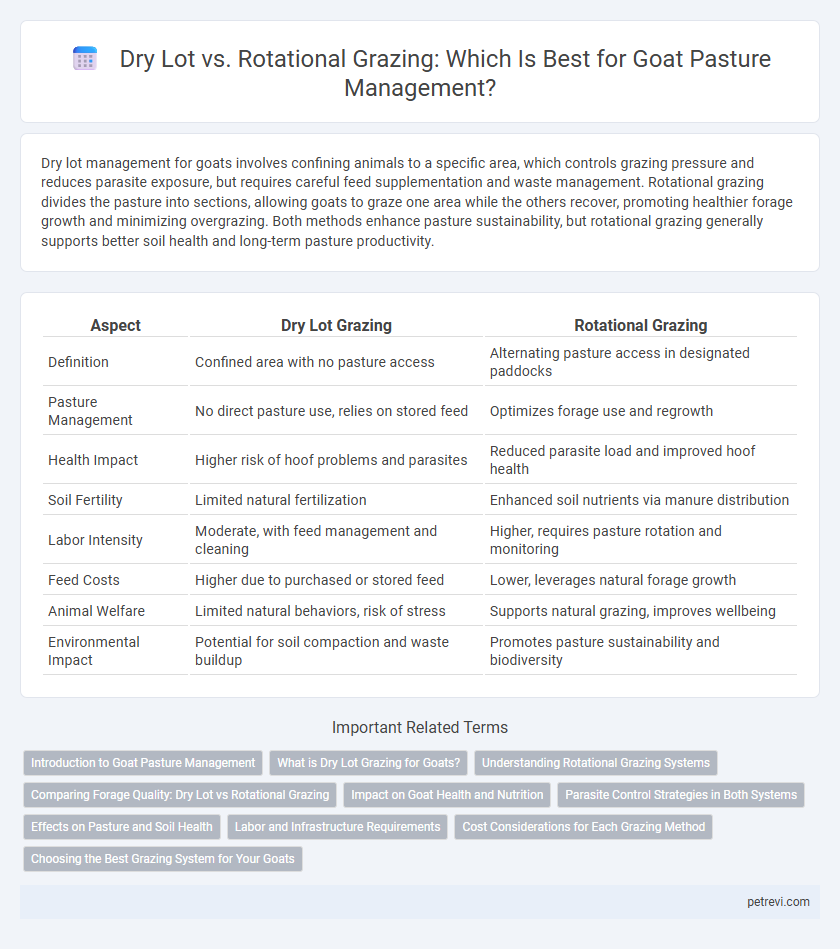Dry lot management for goats involves confining animals to a specific area, which controls grazing pressure and reduces parasite exposure, but requires careful feed supplementation and waste management. Rotational grazing divides the pasture into sections, allowing goats to graze one area while the others recover, promoting healthier forage growth and minimizing overgrazing. Both methods enhance pasture sustainability, but rotational grazing generally supports better soil health and long-term pasture productivity.
Table of Comparison
| Aspect | Dry Lot Grazing | Rotational Grazing |
|---|---|---|
| Definition | Confined area with no pasture access | Alternating pasture access in designated paddocks |
| Pasture Management | No direct pasture use, relies on stored feed | Optimizes forage use and regrowth |
| Health Impact | Higher risk of hoof problems and parasites | Reduced parasite load and improved hoof health |
| Soil Fertility | Limited natural fertilization | Enhanced soil nutrients via manure distribution |
| Labor Intensity | Moderate, with feed management and cleaning | Higher, requires pasture rotation and monitoring |
| Feed Costs | Higher due to purchased or stored feed | Lower, leverages natural forage growth |
| Animal Welfare | Limited natural behaviors, risk of stress | Supports natural grazing, improves wellbeing |
| Environmental Impact | Potential for soil compaction and waste buildup | Promotes pasture sustainability and biodiversity |
Introduction to Goat Pasture Management
Dry lot management confines goats to a controlled area without pasture, emphasizing feed control and minimizing parasite exposure but limiting natural forage intake. Rotational grazing moves goats through subdivided paddocks, promoting pasture regrowth, optimizing nutrient uptake, and reducing parasite load through rest periods. Effective goat pasture management balances forage quality, animal health, and sustainable land use to maximize productivity and welfare.
What is Dry Lot Grazing for Goats?
Dry lot grazing for goats involves confining goats to a small, dirt or gravel area without pasture access, allowing precise control over feed intake and minimizing pasture degradation. This method reduces parasite exposure by limiting contact with contaminated soil and vegetation, promoting healthier goats. Dry lot systems require providing supplemental feed and clean water, making them suitable for intensive management and confinement during adverse weather or overgrazing periods.
Understanding Rotational Grazing Systems
Rotational grazing systems divide pasture into multiple smaller paddocks, allowing goats to graze intensively in one section while others rest and regenerate, promoting healthier forage and soil. This method improves pasture sustainability compared to dry lot systems, which confine goats to a limited, often vegetation-free area, relying on supplemental feed and increasing manure concentration. Implementing rotational grazing enhances nutrient cycling, reduces parasite loads, and supports natural goat behaviors, optimizing overall pasture management.
Comparing Forage Quality: Dry Lot vs Rotational Grazing
Dry lot systems often result in lower forage quality due to limited plant regrowth and higher feed costs, while rotational grazing enhances forage quality by allowing optimal regrowth and nutrient recycling. Rotational grazing promotes diverse plant species and reduces overgrazing, leading to higher crude protein and digestibility levels in goat pasture. Studies show rotational grazing can increase forage quality by up to 20% compared to dry lot management, improving animal performance and pasture sustainability.
Impact on Goat Health and Nutrition
Rotational grazing improves goat health by promoting diverse forage availability and reducing parasite load, which enhances nutrient intake and overall immune function. Dry lot management limits forage variety but helps control parasite exposure and allows precise nutritional supplementation to meet specific dietary needs. Balancing pasture rotation with dry lot feeding strategies optimizes goat health and maximizes nutrient utilization.
Parasite Control Strategies in Both Systems
Dry lot management limits goats' exposure to parasite larvae by confining them to parasite-free areas, effectively reducing the risk of re-infection and enabling targeted deworming protocols. Rotational grazing disrupts parasite life cycles by moving goats between paddocks, allowing resting pastures to naturally diminish parasite populations, which enhances overall herd health. Integrating frequent pasture rotation with fecal egg count monitoring optimizes parasite control in rotational systems, whereas dry lot systems benefit from strict sanitation and regular manure removal to minimize parasite burdens.
Effects on Pasture and Soil Health
Dry lot management confines goats to a specific area, which can lead to soil compaction, nutrient buildup, and uneven pasture utilization, negatively impacting soil structure and forage regeneration. Rotational grazing systematically moves goats through subdivided pasture sections, promoting uniform grazing, enhancing plant root recovery, and boosting soil organic matter. This method improves soil aeration, increases microbial activity, and reduces parasite loads, leading to healthier, more productive pasture ecosystems.
Labor and Infrastructure Requirements
Dry lot goat management demands minimal fencing and infrastructure but requires increased daily labor for feeding, watering, and manure management. Rotational grazing necessitates extensive fencing systems and water points to facilitate pasture movement, with labor focused on moving goats and monitoring pasture health. Efficient planning of infrastructure in rotational grazing reduces long-term labor compared to the intensive manual work in dry lot systems.
Cost Considerations for Each Grazing Method
Dry lot management for goats involves higher initial costs due to the need for infrastructure such as pens, feeders, and regular feed purchases, but lowers land costs and allows better control over nutrition. Rotational grazing requires investment in fencing and water systems but can reduce feed expenses by promoting pasture regrowth and improving forage utilization. Long-term cost efficiency often favors rotational grazing as it enhances pasture productivity and lowers feed supplementation compared to the sustained feed purchases and labor in dry lot systems.
Choosing the Best Grazing System for Your Goats
Rotational grazing enhances pasture health by allowing forage regrowth and reduces parasite load, making it ideal for sustainable goat management. Dry lot systems concentrate goats in confined spaces, simplifying manure control but requiring more supplemental feed and higher management costs. Selecting the best grazing system depends on pasture size, forage availability, labor resources, and the specific nutritional needs of your goat herd.
Dry lot vs Rotational grazing for Goat pasture management Infographic

 petrevi.com
petrevi.com